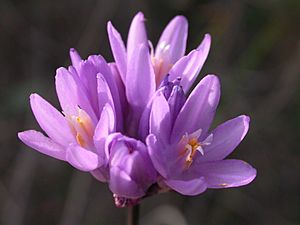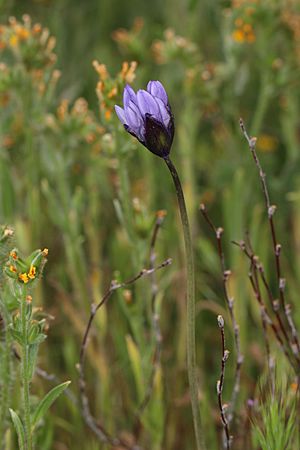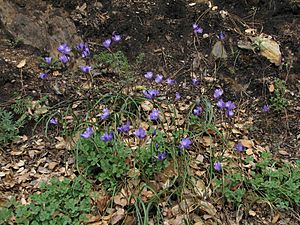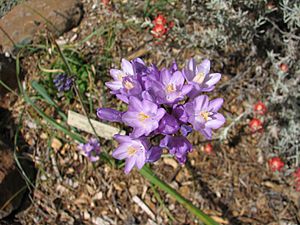Dichelostemma capitatum facts for kids
Quick facts for kids Dichelostemma capitatum |
|
|---|---|
 |
|
| Scientific classification | |
| Synonyms | |
|
Brodiaea lacuna-vernalis |
Dichelostemma capitatum is a beautiful flowering plant often called blue dicks, purplehead, or brodiaea. It belongs to the Asparagaceae family, which also includes asparagus! This plant grows naturally in the western parts of the United States and northwest Mexico. You can find it in states like Arizona, California, Oregon, Utah, and New Mexico.
Contents
What is Dichelostemma capitatum?
This plant is a perennial, meaning it lives for more than two years. It grows from a special underground bulb called a corm. The plant can reach up to 60 centimeters (about 2 feet) tall. It usually has 2 to 3 leaves, which can be 10 to 40 centimeters long.
The flowers grow in a cluster that looks like a small head or umbrella. Each cluster usually has 2 to 15 flowers. These flowers can be blue, blue-purple, pink-purple, or even white. The flower tube is narrow and bell-shaped. Each flower has six parts that help it make seeds. The plant also has a twisted stem and black seeds.
Dichelostemma capitatum can make new plants in two ways: from seeds and from small corms called cormlets. These cormlets grow from the main corm.
Where Does It Grow?
This plant grows in many different places, from sea level up to 2,300 meters high. You can find it in vernal pools (seasonal ponds), grasslands, scrub areas, coniferous forests, and open woodlands.
It loves open areas, especially after a fire. After a fire, the plant grows very well because there's more sunlight and nutrients in the soil. Its corms can stay hidden underground for many years, waiting for the right conditions, like a fire, before they start to grow. If there are no fires, other plants might grow too much, creating too much shade and competition. This can make it harder for Dichelostemma capitatum to thrive.
How People and Animals Use It
For a long time, Native American tribes in California and other regions gathered the corms of this plant. These corms were an important source of starch (energy) in their diet. Different tribes and families would gather the corms at different times, either before, during, or after the plant flowered. They often had special places where they would gather these plants every year.
Animals also enjoy eating these corms! Black bears, mule deer, wild pigs, rabbits, and pocket gophers all munch on them. When animals eat the corms, they also help spread the plant. They might detach the small cormlets, which helps new plants grow. This also helps to loosen the soil and thin out the plant population, making it healthier.
Sometimes, people grow Dichelostemma capitatum in gardens. Its flowers look great mixed with other native California plants, like California poppies. It takes a few years to grow from seeds, but with care, these plants can become very impressive in the spring.
Caring for Dichelostemma capitatum

Native people had many ways to help these plants grow well for future harvests. Some of their methods included:
- Breaking off small cormlets from harvested plants and replanting them.
- Leaving some whole plants untouched to continue growing.
- Gathering corms after the plants had made seeds, then putting the seeds back into the ground.
- Using controlled burning in certain areas.
- Setting up simple irrigation systems.
Digging and thinning the corms, or separating the cormlets and replanting them, helped increase the number of plants. This digging also acts like tilling the soil, which makes the soil better, reduces weeds, and helps seeds sprout. Dichelostemma capitatum needs some disturbance to stay healthy and grow. So, the traditional harvesting methods used by indigenous people actually helped these plant populations thrive. If the plants get too crowded, dividing them can make them stronger.
Growing New Plants
If you plant seeds in the fall, they usually sprout easily without any special treatment. However, it takes several years for plants grown from seeds to be big enough to flower. It's much easier to grow new plants from corms.
Subspecies
- Dichelostemma capitatum subsp. capitatum
- Dichelostemma capitatum ssp. pauciflorum (Torrey) Keator (also known as desert hyacinth)



